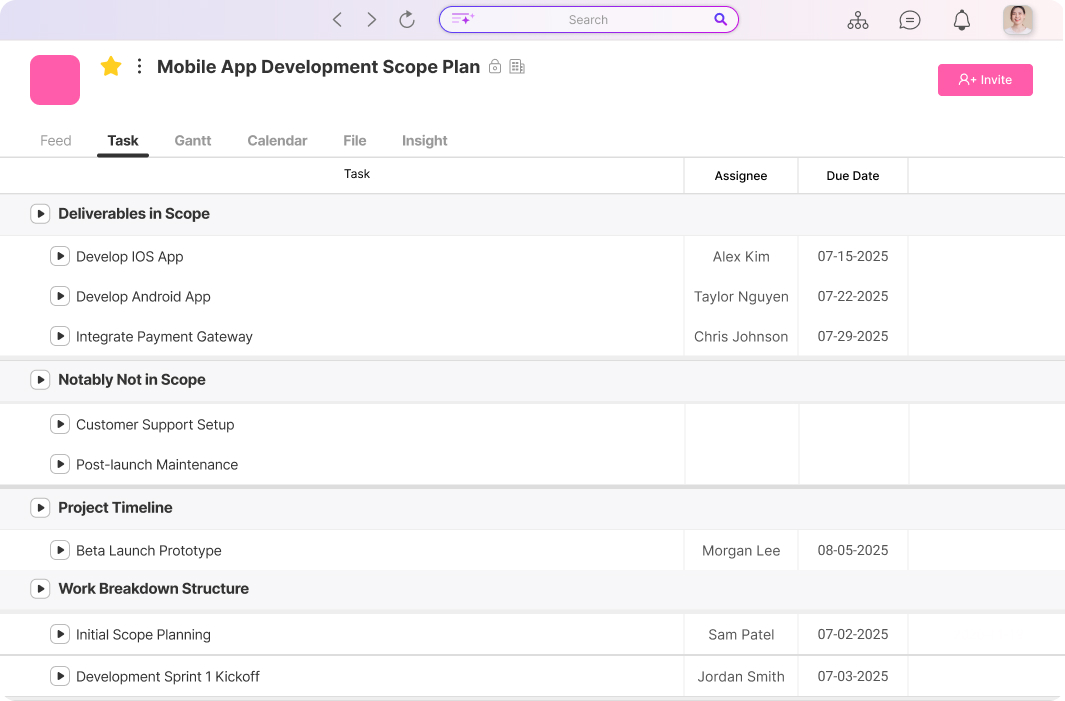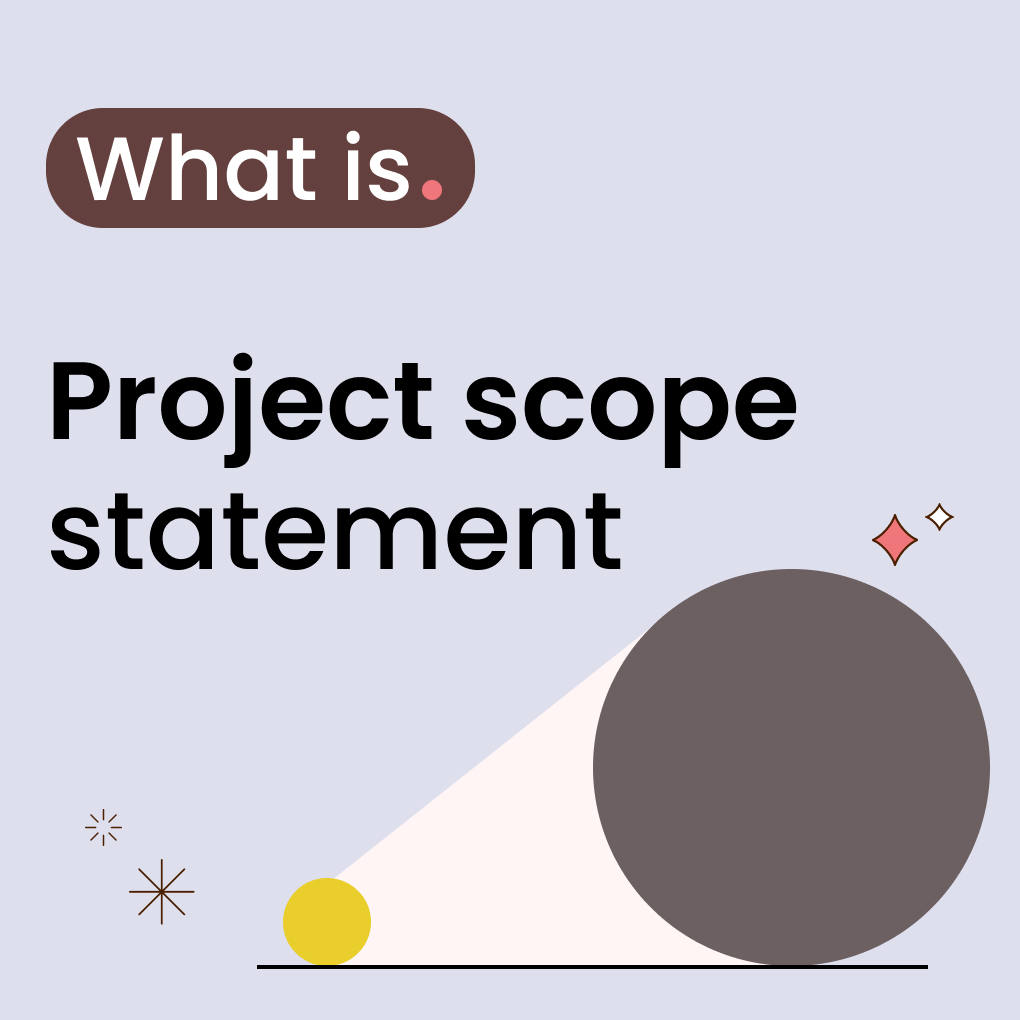Defining project scope is one of the most crucial steps in successful project management. Without a clearly defined scope, teams risk missed deadlines, budget overruns, and the dreaded scope creep that can derail even the best-planned initiatives.
A well-crafted project scope statement sets clear boundaries, outlining what a project will and won’t deliver. It keeps teams aligned, manages stakeholder expectations, and ensures resources stay focused on delivering the intended outcomes.
In this guide, we’ll explain the meaning of project scope, why it’s critical, and show you how to write an effective project scope statement—complete with real-world examples and templates.
What Is Project Scope?
Understanding the definition of project scope is fundamental in project management. It defines a project’s goals, boundaries, deliverables, and constraints, serving as a blueprint for execution.
Definition of Project Scope in Project Management
In project management, project scope refers to a detailed outline of what the project will accomplish and what it will not. It sets the stage for what is included in the work and ensures that all stakeholders, including the project team, understand the project’s limits. A clear project scope definition is essential to prevent wasted resources on non-essential tasks.
For example, the project scope for a website redesign might include creating new page layouts but exclude content creation and post-launch maintenance.
Why Project Scope Matters
A clear project scope ensures that the team works within defined boundaries, avoiding scope creep—unapproved expansion of the project’s objectives. A strong project scope statement:
- Clarifies expectations for all stakeholders
- Helps assign tasks effectively
- Keeps the project focused and organized
- Prevents budget and timeline overruns
Without it, teams risk miscommunication, inefficiencies, and costly project delays.
What Does the Project Scope Include?
A comprehensive project scope covers:
- Objectives: What the project aims to achieve
- Deliverables: The specific outputs of the project
- Constraints: Budget, time, and resource limitations
- Exclusions: Tasks or work not included in the project
- Acceptance Criteria: Standards for deliverable approval
Learning how to write a project scope ensures these elements are explicitly documented.
What Does Project Scope Mean in a Proposal?
In a proposal, project scope outlines the work to be performed, the conditions of that work, and what the client or stakeholder can expect. A clear project scope in a proposal:
- Defines the project’s boundaries
- Helps secure stakeholder buy-in
- Reduces the risk of disputes later
Knowing how to write a scope document or scope statement is crucial for writing persuasive proposals that set realistic expectations.
Project Scope vs. Scope Statement vs. Scope of Work
While closely related, project scope, scope statement, and scope of work are distinct concepts in project management. Understanding the differences helps teams document requirements accurately.
Definitions and Differences
- Project Scope: High-level outline of a project’s objectives, deliverables, and boundaries.
- Project Scope Statement: Formal document expanding on the project scope with detailed objectives, exclusions, assumptions, and constraints.
- Scope of Work (SOW): Detailed breakdown of tasks, responsibilities, schedules, and deliverables.
A simple way to think about it: the project scope defines the “what,” the scope statement refines it, and the scope of work explains “how” the work gets done.
When to Use Each Document
The project scope requirements are outlined early during planning to align stakeholders. The project scope statement comes next, formalizing these requirements into an approved document. A project scope sample helps teams understand what to include. The scope of work appears last, providing contractors or teams with step-by-step instructions.
Scope vs. Goals vs. Deliverables
- Scope: Defines the work and boundaries of a project.
- Goals: Broader outcomes the project aims to achieve.
- Deliverables: Specific tangible outputs produced during the project.
Clearly differentiating these helps prevent confusion and keeps projects on track.
What Is a Project Scope Statement?
A project scope statement is a detailed document that defines what a project will deliver, under what conditions, and by when. It serves as an agreement between stakeholders and the project team.
Purpose and Importance
The primary purpose of a project scope statement is to prevent miscommunication, provide clear guidelines for execution, and offer a framework for measuring success. It’s an essential reference point throughout the project lifecycle.
What Is Included in a Scope Statement?
A strong project scope statement typically includes:
- Project objectives and goals
- Detailed deliverables
- Milestones and deadlines
- Constraints and limitations
- Exclusions (what’s not included)
- Assumptions and acceptance criteria
For example, a sample scope statement for an IT project would specify system features, development milestones, and exclude user training post-deployment.
How Does a Project Scope Statement Help a Project Team?
An effective scope statement keeps the team:
- Focused on authorized work only
- Clear about deadlines and responsibilities
- Aligned with stakeholder expectations
It acts as a roadmap, reducing confusion and ensuring efficient project execution.
How to Write a Project Scope Statement
Writing a project scope statement involves a methodical approach to ensure clarity and comprehensiveness.
Step 1 – Define Project Goals and Objectives
Start by clarifying the “why” behind the project:
- Goals are broad, overarching aims (e.g., “Enhance customer service responsiveness”).
- Objectives are measurable steps to achieve those goals (e.g., “Reduce average customer response time to under 24 hours within 3 months”).
Step 2 – List Requirements and Deliverables
Identify what needs to be delivered:
- Requirements describe specifications (e.g., “Mobile-friendly design”).
- Deliverables are the tangible outputs (e.g., “Redesigned homepage”).
Be as specific as possible to avoid ambiguity.
Step 3 – Set Exclusions and Constraints
Document what is not included (exclusions) and any known limitations (constraints):
- Example exclusion: “Ongoing website maintenance post-launch.”
- Example constraint: “Project must be completed within a $50,000 budget.”
Step 4 – Outline Milestones and Timeline
Set clear checkpoints to measure progress:
- Key milestones (e.g., “Prototype complete by August 1”)
- Project timeline (e.g., “Launch website by October 15”)
This keeps teams on schedule and stakeholders informed.
Step 5 – Get Approval and Sign-Off
Once finalized, circulate the scope statement for stakeholder approval. A signed-off scope document helps:
- Avoid future disagreements
- Protect against scope creep
- Provide a reference if disputes arise
Project Scope Examples & Templates

Examples and templates help illustrate how to define scope in project management.
General Project Scope Example
Project: Website Redesign
Scope Includes:
- Redesigning homepage, about us page, and blog section
- Mobile responsiveness across devices
- SEO optimization for all pages
Scope Excludes:
- New content creation
- Post-launch maintenance
Constraints:
- Budget: $40,000
- Timeline: 12 weeks
Sample Scope Statement for IT Project
Project: Inventory Management System
Scope Includes:
- Develop software for barcode scanning
- Real-time inventory tracking dashboard
Scope Excludes:
- Staff training post-deployment
Constraints:
- Must integrate with existing ERP system
- Budget limit: $80,000
Scope of a Project Proposal Example
Proposal for New Mobile App:
Scope Includes:
- iOS and Android versions
- User registration, profile management, payment gateway integration
Scope Excludes:
- Customer support setup
Including a detailed scope in proposals helps stakeholders set clear expectations early.
Scope Management Best Practices
Managing project scope effectively is key to delivering successful results. Here are some best practices:
Involve Stakeholders Early
Early stakeholder engagement:
- Improves scope accuracy
- Reduces rework later
- Builds buy-in for project success
Set Boundaries to Prevent Scope Creep
Define clear inclusions and exclusions in your scope document. When new requests arise, evaluate them carefully and update the scope formally if necessary.
Keep Scope Documents Accessible
Ensure all team members have easy access to the latest project scope statement. This promotes consistency and prevents confusion.
Regularly Revisit Your Scope During the Project
Schedule regular reviews of the project scope to ensure the project stays aligned with the original plan. Adjust only when formally approved.
Conclusion
A clear, well-documented project scope is essential for project success. It provides structure, keeps teams aligned, and helps manage stakeholder expectations.
By learning how to write a project scope, creating strong scope statements, and following scope management best practices, teams can minimize risks and deliver better outcomes.
Using tools like Morningmate to collaboratively define and manage scope documents ensures transparency and helps teams stay on track—from planning to successful project delivery.




